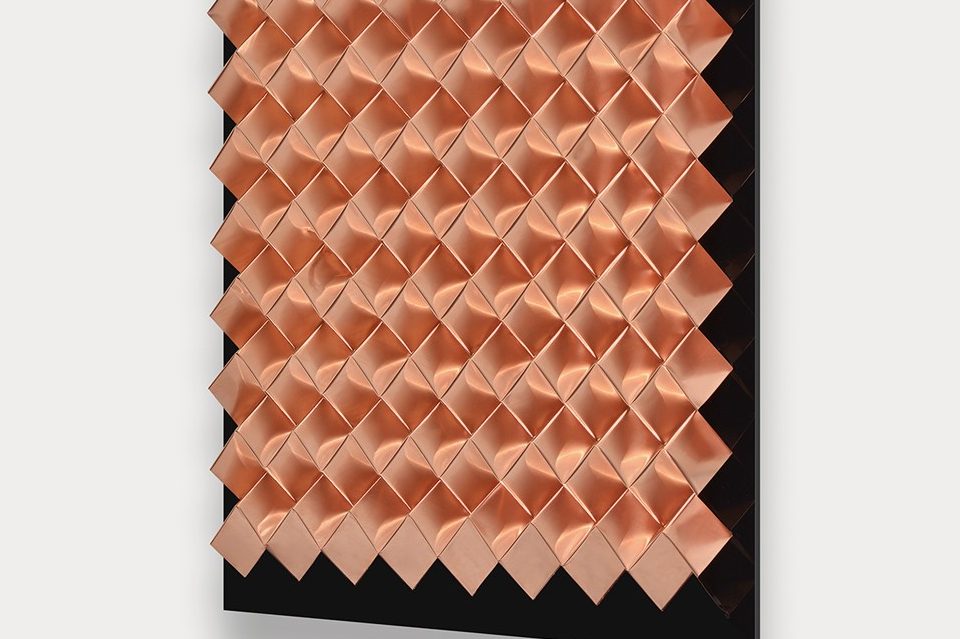
May, 2018
Geometric designs have always been popular in architecture and interior design. It is not a contemporary trend; it is one that has endured throughout history. Adele Orcajada from MaterialDriven tells us more.
The Ancient Greeks, the Moroccans or the Scandinavians have all historically used bold geometric patterns to reflect their cultural identity. Modernity was shaped by the Art Deco trend, at the beginning of the 20th century, which was full of angular structures and geometric patterns that inspired artists and designers from fashion to graphics, changing the way art was understood.
And like so many enduring designs, geometric patterns become a trend over and over again. You can find them in prints and patterns all over soft furnishings or wallpapers, on architectural facades or in 3 dimensional products such as vases or furniture. As material researchers at MaterialDriven we have also noticed that there is currently a strong geometric pattern trend coming from material innovation.
As with geometry, material innovation is at the crossroads between art and science, between the technical and the artistic. Material makers are often inspired by nature and the natural patterns that come from it, looking to replicate or mimic them in their work. Here are some exciting materials that work with geometric patterns.
Foldcore incorporates geometric shapes into the actual construction of the material. By folding the material in different ways, similar to origami techniques, a wide range of aesthetic effects can be achieved as well as functionality. These may be used in sandwich applications, to produce strong and lightweight structures for aerospace, automotive or shipbuilding. However the beauty of these folded panels is so unique they have a range of products exclusively developed for artistic and decorative purposes. This range is called Foldart. Using bow paper, aluminium or copper, the sheets are folded without a single cut or adhesive. The results are an incredible combination of shape, colour and light.
Biomarble is an exciting material developed by Hannah Elisabeth Jones, a graduate from Manchester School of Art. Biomarble is a new, flexible material (patent pending) with a unique and intriguing surface pattern, made from waste paper. Jones has been developing BioMarble to perfect its durability, visual aesthetic and quality of colour. Inspired by her training in Textiles she combines geometric units that are cut from a palette of different material colours, then stitched together in an ombré formation, using traditional patchwork techniques to form 3-Dimensional tessellations. Her work has been used as featured wall art installation in galleries and exhibitions such as GK Gallery, Surface Design Show, or London Design Week.
Biohm develops materials that are inspired by nature and do not harm our environment. Using raw materials such as mushroom mycelium or organic waste they are pushing the boundaries of material innovation. One of their materials is called Orb (organic refuse biocompound). To produce Orb they transform organic waste into a valuable and functional material. Biohm organically binds food waste or agricultural waste into a material which could be formed into sheets or moulded to create intricate three dimensional shapes. It is an affordable substitute for semi-structural wood-based sheet material or for sustainable interior decoration and furniture. Some of the shapes they have developed are clearly inspired by Arab and Moroccan designs, using geometry to highlight the textures and the colours of this waste material
But Biohm takes geometry a step further, using it as inspiration not only for material development but to design an interlocking construction system that does not require permanent binders or fasteners to create durable robust structures. This is called Triagomy.
Triagomy is a delicate balance between parametric design and natural structural engineering. The design is based on sections of a hexagon (triagonals) that can be found in natural structures such as bee hives and carbon. These structure allow them to achieve structural integrity.
Whether it is in function or form, geometry is a key source of inspiration for material innovators who are looking for new ways to shape our futures.
The new Duraflor range of Hexagonal Tiles inspired by geometric trends can be seen now at our London Showroom at The Design Hub, 47 Gee Street, Clerkenwell – if you would like more details please email [email protected]
Feature Image: an example of Foldart from Foldcore
Guest Blog: Adele Orcajada from MaterialDriven